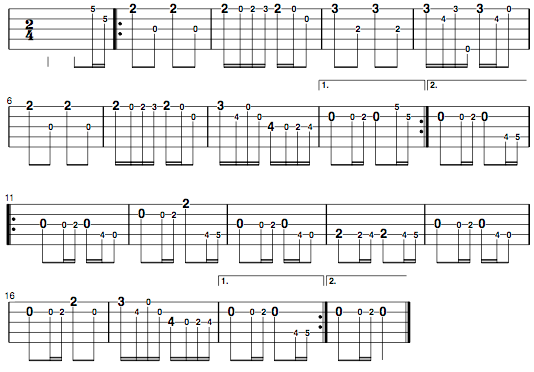Episode 14 – Liberty
“Give me Liberty or give me death!” This has become the rallying cry of patriots of the Clawhammer Core Repertoire Series.
Say no more! Since I have no interest sacrificing anyone’s mortality for the sake of banjo instructional materials, for this month’s installment of the series I give you……
Liberty!
Though a popular jam favorite, Liberty is one of the notier tunes in our Core Repertoire Series. But, there are two reasons why you should proceed undeterred. First, you don’t have to play all them notes. As you know, you can outline just the basic melody with clawhammer banjo and still sound great, especially in a jam situation where another instrument like the fiddle is carrying the lead.
Second, the melody of Liberty lays out quite nicely in double D tuning, so it’s a great tune for getting your feet wet if you’re looking to try your hand at a little more melodic style of playing (especially if you’re comfortable dropping your thumb). So, in the name of freedom, let’s get on with it!
Here’s a preview of the melodically inspired version I end up with:
Step 1: Know Thy Melody
First things first. As always, before any and all men and womenfolk embark on their quest for Liberty, they must follow the first inalienable law of tune learning: know thy melody. Fortunately, I have scoured the corners of the cyberworld, and in my travels collected the following specimens for further melodic study:
Example 3 (my favorite)
Listen to these, or any other versions of Liberty you may be fond of, enough times so that you have its fundamental melodic essence firmly in mind. Fiddlers do like to put their personal stamp on a tune, and so may take certain…ahem…liberties with the arrangement. But you should be able to hear a common melodic thread in these examples. Once you’ve got it in your noodle, proceed with step 2.
Step 2: Find the Melody Notes
It is never been said that no man is free until he can find ring the notes of Liberty from his 5 string…until now. First, this is what I hear as the basic melodic contour of this tune (A and B parts just played one time through):
And here’s what that looks like in tab:

As I said earlier, this tune is on the notier side, hence our basic skeletal melody is a little busier than some.
Step 3: Add some clawhammery stuff
Now we can take that basic arrangement, throw in a bum ditty after striking each of the notes that occur on the downbeat (the notes in bold), and end up with an arrangement that any of our fellow sawstroking revolutionaries would be happy to be accompanied by.

You’ll note hear that I’ve include the chords in this arrangement. I personally tend to hold down the chord shapes even if I’m not going to be striking any of the strings I’m holding down, as I find it makes for a more harmonious sound from the banjo (it also helps ensure that if you happen to miss a string, it’ll still sound good!)
Here’s how that arrangement sounds:
And now if we pair this arrangement with the fiddle, we get:
Step 4: Let Freedom Ring
Now’s your chance to take your own…ahem…liberties with this arrangement. As I said earlier, though this tune is quite busy, it’s a good one for trying your hand at a more melodic style if it’s not something you’re not that comfortable with. The A part in particular can be pulled off pretty easily with a minimum of fretting hand pyrotechnics.
You can hear how my final arrangement sounds in the video above, and you’ll find that it’s a pretty faithful rendering of the melody. And here’s what the tab looks like (note: a “T” under the measure indicates the note is played with the thumb; the numbers under the measure indicate the finger of the fretting hand I use to execute the alternate string hammer on):

Step 5: Practice smart
Now it’s time to burn this one into your brain circuits. My favorite place to start doing so are the Beats for Banjo tracks (select tempo through the playlist icon on the upper right):